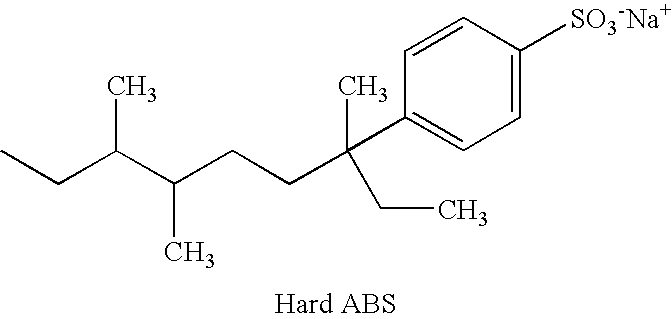Specific Branched Aldehydes, Alcohols, Surfactants, and Consumer Products Based Thereon
a technology of specific branched aldehydes and alcohols, applied in the field of new aldehydes, detergent alcohols, surfactants and consumer products, can solve the problems of inhibiting biodegradability, limited use of abs and related alcohols in laundry or other consumer products, and slow evolution of the class sometimes called “mainframe surfactants” , to achieve the effect of high solubility, good biodegradability and high efficiency
- Summary
- Abstract
- Description
- Claims
- Application Information
AI Technical Summary
Benefits of technology
Problems solved by technology
Method used
Image
Examples
synthesis example i
Using PROCESS SCHEME I
Synthesis of Farnesene Derived Poly-Branched Poly-Olefin Containing Aldehyde and Mixtures Thereof
[0049]1.6 grams of Carbonylhydridotris(triphenylphosphine)rhodium(I) [17185-29-4], 3.0 grams of Triphenylphosphine [603-35-0], and 336 grams of a mixture of isomers of alpha-farnesene [502-61-4] are charged to a 600 mL stainless steel stirred pressure vessel. The reactor is purged of air using vacuum and nitrogen cycles then charged with a 2:1 ratio mixture of carbon monoxide and hydrogen to an initial pressure of 300 psig. The reactor is heated to 85° C. with agitation with a magnetic stir bar at 500 rpm and the pressure is adjusted to 600 psig using a 2:1 ratio mixture of carbon monoxide and hydrogen. As carbon monoxide and hydrogen are consumed by the reaction, the pressure is maintained by using a 1:1 ratio mixture of carbon monoxide and hydrogen. The contents of the reactor are sampled with time and analyzed by gas chromatography (“GC”) to monitor the progress ...
synthesis example ii
Using PROCESS SCHEME I Steps c,d
Synthesis of Farnesene Derived Poly-Branched Alcohol and Mixtures Thereof
[0050]20 grams of Nickel on Kieselguhr (60-weight % loading) and 200 mL of tetrahydrofuran are charged to a 600 mL stainless steel stirred pressure vessel. The reactor is purged of air using vacuum and nitrogen cycles then charged with hydrogen to an initial pressure about 600 psig. The mixture is heated to about 150° C. with stirring at 500 rpm. Hydrogen is charged to a final pressure of about 1000 psig and maintained at this pressure for 16 hours. The contents of the reactor are then cooled to room temperature and the pressure is reduced to about 50 psig.
[0051]The mixture obtained from Synthesis Example I is then charged to the reactor while excluding the introduction of air from the atmosphere while continuously stirring the reactor contents. The hydroformylation catalyst from Synthesis Example 1 may remain with the aldehyde mixture or may be removed from the aldehyde mixture ...
synthesis example iii
Using PROCESS SCHEME I
Synthesis of a Farnesene Derived Mixture Primarily Consisting of 4,8,12-Trimethyl-tridecan-1-ol (Alcohol 1) and 3-Ethyl-7,11-dimethyl-dodecan-1-ol (Alcohol 2) and Mixtures Thereof
[0053]A 600 mL stainless steel stirred pressure vessel with magnetic stir bar agitation is used as Reactor #1, using vacuum to draw in the materials while avoiding air. 1.80 grams of Carbonylhydridotris (triphenylphosphine) rhodium(I) [17185-29-4] and 5.84 grams of Xantphos [161265-03-8] were slurried in 77 grams of pentane and charged to Reactor #1. The pentane is removed using vacuum and no heat, then 50 mls of toluene are added. The reactor is purged of air using vacuum and nitrogen cycles then charged with 10 atm of a 1:1 ratio mixture of carbon monoxide and hydrogen, and heated to 60° C. for two hours and then cooled to 30° C.
[0054]The reactor is placed under vacuum then 100.86 grams of trans-beta-Farnesene [18794-84-8] plus 50 mls of toluene are charged to the reactor while exclu...
PUM
| Property | Measurement | Unit |
|---|---|---|
| total pressure | aaaaa | aaaaa |
| temperature | aaaaa | aaaaa |
| pressure | aaaaa | aaaaa |
Abstract
Description
Claims
Application Information
 Login to View More
Login to View More - R&D
- Intellectual Property
- Life Sciences
- Materials
- Tech Scout
- Unparalleled Data Quality
- Higher Quality Content
- 60% Fewer Hallucinations
Browse by: Latest US Patents, China's latest patents, Technical Efficacy Thesaurus, Application Domain, Technology Topic, Popular Technical Reports.
© 2025 PatSnap. All rights reserved.Legal|Privacy policy|Modern Slavery Act Transparency Statement|Sitemap|About US| Contact US: help@patsnap.com



